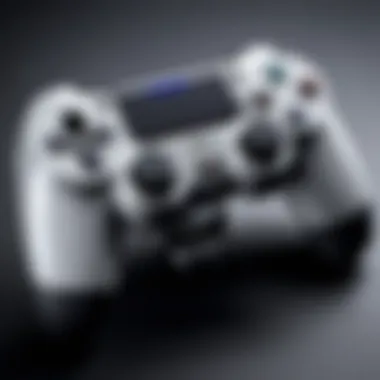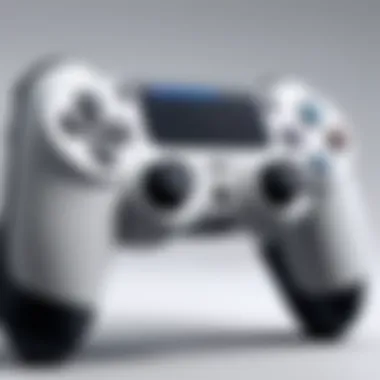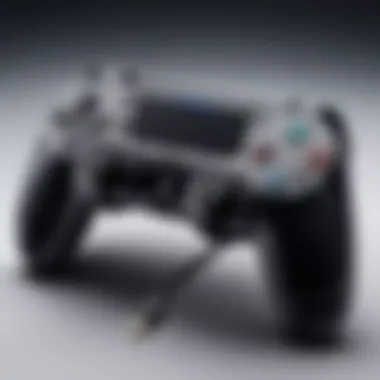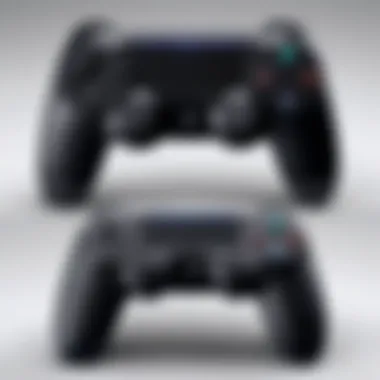Exploring the Original PlayStation 4 Controller


Intro
The original PlayStation 4 controller marked a significant shift in gaming interaction. Released alongside the console in November 2013, this DualShock 4 introduced features that resonated with both casual and competitive gamers alike. As the industry evolved, so did expectations for peripherals that enhance player experience. This article aims to provide an in-depth examination of the PlayStation 4 controller, a device that has held a distinctive place in the hearts of gamers.
By analyzing its design and functionality, we aim to highlight why the DualShock 4 remains relevant even amid new technological advancements. From its comfortable grip to the versatile touchpad, the controller's features are designed to enhance gameplay. We will also explore maintenance tips, compatibility with other systems, and when to consider replacement options.
Now, let’s further explore the world of competitive gaming as it intersects with the PlayStation 4 controller.
Preface to the Original PlayStation Controller
The PlayStation 4 controller is a vital part of the gaming experience on the PS4 console. It not only allows players to engage with their favorite games but also shapes how they interact with various gaming mechanics. Understanding its design, features, and impact on the gaming landscape is key for both players and developers alike. The controller's unique functionalities elevate gameplay and create a more immersive experience.
Historical Context
The original PlayStation 4 controller, known as the DualShock 4, was launched alongside the PlayStation 4 in November 2013. This period marked a turning point in gaming. Developers were transitioning from the previous generation of consoles that relied on more traditional designs. The DualShock 4 brought revised ergonomics and new technological advancements. Understanding the context of its creation involves recognizing how quickly the gaming world was evolving, particularly with the advent of digital distribution and online gaming.
The DualShock 4 controller is a response to both technological trends and player feedback from the previous generation. Features such as the built-in speaker and the touchpad were innovative at the time. Developers aimed to push creative boundaries. The DualShock 4 was not just a controller; it served as a portal to new gameplay possibilities. It represented an intersection between hardware development and gaming mechanics, paving the way for an interactive and engaging gaming experience.
Overview of the PlayStation Launch
The launch of the PlayStation 4 in 2013 was met with great anticipation and excitement. Sony aimed to deliver a console that not only improved performance but also enhanced user experience. Accompanying this new console was the DualShock 4, which became essential for success. Sony crafted a launch plan that showcased the PS4's powerful hardware capabilities and diverse library of available games.
During its release, the DualShock 4 attracted attention for its various improvements, such as the touchpad and integrated light bar. It also featured refined analog sticks and triggers, which brought a new level of precision to gaming. These enhancements contributed significantly to the system's favorable reception among gaming communities. In a market driven by immersive gaming experiences, the DualShock 4 established a solid foundation for the console's success.
The initial launch was supported by a series of exclusive titles that played to the strengths of the new controller. Games like "Killzone: Shadow Fall" and "Knack" demonstrated the capabilities of the DualShock 4, making them standout experiences for the new console environment. This cohesive marriage of hardware and software played a crucial role in convincing many gamers to invest in the PlayStation 4.
Design Features
The design features of the original PlayStation 4 controller play a critical role in its overall functionality and user experience. These elements do not just serve aesthetic purposes; they significantly influence comfort, usability, and performance. Details such as ergonomics, button layout, and visual appeal are crucial for players who spend countless hours gaming. Understanding these aspects will enhance appreciation among esports enthusiasts, technology enthusiasts, and gaming fanatics.
Ergonomics and Form Factor
Ergonomics in controller design are vital for extended gaming sessions. The original PlayStation 4 controller adopts a shape that fits the contour of the hands. This shape allows for a natural grip, which reduces strain and discomfort. The slightly textured grips enhance tactile feedback, contributing to better control.
The weight of the controller is also thoughtfully distributed. Its heft strikes a balance that feels substantial without being cumbersome. Players often find this helps to improve precision during fast-paced games. The form factor encourages a relaxed hand position, allowing gamers to maintain focus on the screen for long periods.
Button Layout and Functionality
The PlayStation 4 controller features a well-thought-out button layout that is intuitive for users. The placement of the buttons is designed to allow quick access during gameplay.
- The face buttons are easily reachable, and their distinctive shapes help with identification.
- The D-pad allows for precise navigation through menus and gameplay mechanics.
- Shoulder buttons are sensitive, providing immediate responses that are crucial in competitive gameplay.
Furthermore, the controller incorporates a touchpad. This additional input method broadens functionality, allowing for new gameplay styles. Players can use swipe gestures or tap commands, enhancing interactivity.
Color and Aesthetics
Color combinations and aesthetics of the original PlayStation 4 controller have contributed to its popularity. The controller is available in various colors, appealing to a wide audience and catering to personal tastes.


The design is sleek, with a modern look that fits well within the gaming landscape. The light bar adds a unique visual element that not only enhances aesthetics but also provides feedback. Different colors indicate player status and other in-game actions, adding a layer of immersion.
The choice of materials also impacts durability and feel. The controller is designed to withstand the wear that comes with regular use, making it a reliable choice for avid gamers.
The PlayStation 4 controller is not just a tool; it is a part of the gaming identity for many users, influencing their engagement and experience.
Technological Advancements
The original PlayStation 4 controller, known for its array of technological advancements, significantly enhanced gaming experiences. These innovations not only improved overall gameplay but also set a new standard for future gaming hardware. This section examines the core technological features of the controller, which have become critical in today’s gaming landscape. Specific elements like Bluetooth connectivity, touchpad functionality, and light bar innovations are explored to understand their impact on user interaction and gameplay.
Bluetooth Connectivity
Bluetooth technology integrated into the DualShock 4 controller provides a seamless and wireless connection to the PlayStation 4 console. This advancement allows for greater freedom of movement during gameplay, as players are not tethered to the console by cables. The connection is robust and reliable, which minimizes lag—a critical factor in competitive gaming. Moreover, this wireless feature simplifies setup, enabling users to quickly connect the controller to the console or switch between multiple devices.
One notable benefit of Bluetooth connectivity is its efficiency. The controller can maintain a stable connection to the PlayStation 4 while consuming minimal battery life. Players often appreciate the convenience of charging the device via a USB cable, which further supports extended gaming sessions without interruptions due to low battery events.
Touchpad Functionality
The introduction of the touchpad on the DualShock 4 controller marks a significant evolution in gaming input methods. The touchpad serves as both a button and a multi-touch interface, allowing for a range of functions beyond traditional button presses. For many games, this means that players can swipe or tap to trigger specific actions, which adds an extra layer of interaction.
Furthermore, the touchpad enhances the user experience by enabling innovative game mechanics. In titles designed for the PlayStation 4, developers have utilized this feature for intuitive gestures, like swiping to change weapons or navigating menus. This adaptability allows for a more immersive experience, encouraging players to interact with the game world in new ways.
Light Bar Innovations
The light bar on the DualShock 4 controller serves multiple functions that reflect its innovation. Initially, it acts as a player indicator, allowing easy identification among multiple controllers at once. However, its purpose extends beyond mere aesthetics. The light bar's colors change based on in-game actions, creating a dynamic feedback system that informs players of their status or health levels in real-time.
In addition, the light bar can be utilized by certain games for enhanced gameplay experiences. For example, in games that utilize virtual reality, the light bar aids in tracking the controller’s position in space, enhancing the overall immersion. The incorporation of this technology highlights how advancements in controller design can significantly impact gameplay mechanics.
"Technological advancements in controllers like the DualShock 4 do not just enhance functionality; they redefine the way players interact with their games."
These technological advancements in the original PlayStation 4 controller illustrate the thoughtful design considered by Sony. Features such as Bluetooth connectivity, touchpad capabilities, and the innovative light bar play an essential role in evolving gaming from simple interactions to a more immersive and responsive experience.
User Experience
User experience (UX) is a crucial aspect when discussing gaming controllers. It directly influences a player's engagement, performance, and satisfaction. The original PlayStation 4 controller embodies several design and technological features that enhance user experience. Understanding these elements provides insight into how they impact gameplay and overall enjoyment.
Gaming Performance
The gaming performance realized through the PlayStation 4 controller is remarkable. The buttons, triggers, and sticks are finely tuned to respond precisely to player inputs. This high-level responsiveness is vital for competitive play, where milliseconds can determine victory or defeat. The lightweight design allows for quick changes in hand position, enabling gamers to execute complex maneuvers with ease.
Moreover, features like the touchpad can facilitate unique interactions. In games that support this functionality, it serves as an additional input method, providing players with more control options. Users have reported that these enhancements contribute positively to their overall performance in various game genres.
Comfort During Extended Use
Comfort is another pillar that defines user experience. The PlayStation 4 controller is ergonomically designed to fit comfortably in a player’s hands, reducing fatigue during long gaming sessions. Its shape accommodates a variety of hand sizes, making it inclusive for a broader spectrum of users.
The materials used for the grips are textured to provide stability and prevent slipping. This thoughtful design extends beyond aesthetics to embrace usability. Gamers appreciate the natural feel of the controller, which allows them to focus on the game without the distraction of discomfort. Extended gameplay sessions become less of a chore and more of an immersive experience.


Feedback from the Gaming Community
Feedback from the gaming community is invaluable when assessing any gaming hardware. Players often share their experiences on platforms like Reddit and various forums. Many gamers commend the PlayStation 4 controller for its reliability and responsive design. Some have noted that the addition of features like vibration feedback enhances the overall experience. This tactile feedback helps in creating a more immersive atmosphere.
However, criticisms also exist. Some users point out issues with the durability of the controller over time. Reports of thumbstick wear and battery issues after prolonged use suggest potential areas for improvement.
Overall, the dialogue within the community provides a nuanced picture of the controller’s impact. These insights matter as they pave the way for future iterations of gaming hardware.
"The PlayStation 4 controller changed how players engage with games, combining comfort and performance in a single device."
Maintenance and Care
Maintaining the original PlayStation 4 controller is essential for ensuring its longevity and optimal performance. The value of caring for this piece of technology goes beyond mere aesthetics; it significantly enhances the user experience and overall functionality. By dedicating time to maintenance, users can prevent issues that might otherwise lead to costly replacements or a diminished gaming experience.
Cleaning and Upkeep
Regular cleaning is crucial for any gaming device, particularly controllers that are directly handled during use. Accumulation of dirt, dust, and grime can affect the controller's buttons and touchpad responsiveness. Here are some specific recommendations for upkeep:
- Surface Wipe: Use a slightly damp microfiber cloth to gently wipe down the exterior. This prevents scratches and removes surface dirt.
- Disinfecting: Especially during times of illness, consider using disinfectant wipes on the outer surfaces while avoiding saturation, which could damage internal components.
- Button Care: Ensure that debris does not build up around the analog sticks and buttons. A soft brush or compressed air can help remove particles that may affect operation.
Maintaining the aesthetic quality of the controller also contributes to preserving its value. An unkempt controller might not only feel unpleasant but also reduce its resale potential.
Troubleshooting Common Issues
Despite the durability of the PlayStation 4 controller, users may encounter problems over time. Immediate attention to these issues can prevent them from evolving into larger concerns.
Some common issues include:
- Connection Problems: If the controller frequently loses connection, ensure it's charged and try resetting it by using a pin to press the small reset button on the back.
- Drifting Analog Sticks: Drifting may occur with regular use, where the analog sticks register movement when untouched. Cleaning around the joystick areas can help mitigate this issue. Users can consider recalibrating the sticks via the PS4 settings if problems persist.
- Battery Life Deterioration: Over time, battery life may decline. If the controller no longer holds a charge, it might need replacement. Be aware of any signs of swelling, which indicates the need for immediate replacement owing to safety risks.
"Proper maintenance and prompt troubleshooting can significantly enhance the gaming experience and extend the life of your PlayStation 4 controller."
Active engagement with these maintenance and troubleshooting strategies allows users to maximize the value and functionality of their controller, ensuring a smooth gaming experience.
Compatibility and Connectivity
Compatibility and connectivity are crucial facets of the original PlayStation 4 controller's overall functionality and user experience. As gaming technology evolves, the need for seamless integration across a variety of devices grows increasingly important. The original PlayStation 4 controller was designed to facilitate smooth interaction not only with the PlayStation 4 console itself but also with other devices, enabling users to enhance their gaming repertoire.
The main benefit of the controller’s compatibility lies in its ability to connect to diverse devices. This versatility ensures that gamers can maximize their gameplay experience whether on a console, PC, or other platforms. Such flexibility permits instances where the controller can be used for non-gaming multitasking too, such as navigating user interfaces or managing media playback.
In addition to improving user experience, compatibility often leads to prolonged use of the controller. Players can switch up their setup without the need to purchase additional gear, thereby extending the life cycle of the original accessory. This can be particularly appealing for those who enjoy experimenting with different setups for various gaming genres or tasks.
However, these considerations regarding compatibility do not come without challenges. Connecting to devices requires a sound understanding of different connection standards, protocols, and potentially, software drivers. Furthermore, players must be mindful of limitations imposed by certain platforms which may restrict their functionality. Therefore, an understanding of these aspects becomes essential for the dedicated gamer.
Connecting to Other Devices
Connecting the original PlayStation 4 controller to other devices can be accomplished in various ways, primarily through Bluetooth, which is its default mode of communication. This wireless technology allows players to enjoy a clutter-free gaming environment. The process for pairing can vary slightly depending on the device but generally involves the following steps:


- Power On the Controller: Hold the PlayStation button until the light bar illuminates.
- Initiate Pairing Mode: Simultaneously press the Share button and the PlayStation button until the light bar starts to flash.
- Complete the Connection: Navigate to your device's Bluetooth settings and select the controller from the list of available devices.
This simple process enables quick connections across systems, allowing players to circumvent the usual lag associated with wired connections. For example, PC gamers can experience the familiar comfort of the PlayStation layout without investing in a new controller.
In addition to Bluetooth connectivity, players can use a USB cable to connect directly to compatible devices for charging or wired gaming sessions. This method ensures a stable connection but limits movement, which may not suit everyone’s gaming style. It's practical during charging or when latency needs to be minimized.
Switching Between Platforms
Switching between platforms using the PlayStation 4 controller is a feature that elevates its appeal. The controller can be used on different systems such as Windows PCs, Android devices, and even certain smart TVs. This cross-platform capability encourages a diverse gaming experience.
However, it is necessary to mention that transitioning between platforms may require slight adjustments. For example, when moving from PlayStation 4 to a PC, users may need to rely on additional software such as DS4Windows to customize settings. This program allows for the remapping of buttons and the configuration of macros, enhancing compatibility with various games on the PC.
Players should also be aware that not all games recognize the controller or its features. Some titles may limit functionality or require manual adjustments. Therefore, checking compatibility before making any switches is wise, particularly for competitive gaming scenarios.
"Adaptability is key in gaming. Being able to switch between platforms without needing a new controller enhances the overall experience and keeps gamers engaged."
Replacement and Aftermarket Options
The original PlayStation 4 controller has become a staple in the gaming community since its release. Even though it was widely praised for its ergonomic design and features, like any piece of technology, it is not exempt from wear and tear. Understanding when to replace your controller and exploring aftermarket options becomes necessary for a fulfilling gaming experience. This section sheds light on these critical aspects.
Identifying When to Replace
Recognizing the signs that your PlayStation 4 controller needs replacement is crucial. Some indicators are rather obvious, while others may be entirely subtle.
- Physical Damage: Look for cracks, broken buttons, or any visible damage on the exterior. These issues can hinder gameplay.
- Battery Life: If you notice significantly reduced battery performance even after charging fully, it may be time for a replacement. Controllers should retain their charge well.
- Connectivity Issues: Inconsistent Bluetooth connectivity can be a red flag. If the controller disconnects frequently or takes longer to reconnect, it might be failing.
- Stick Drift: One common complaint among gamers is joystick drift, where the character moves without any input. If this occurs, replacing the controller could be a solution.
Monitoring these signs not only prolongs your gaming sessions but also keeps the experience enjoyable. If you notice these issues persistently, consider investing in a new controller to enhance your gameplay.
Evaluating Third-Party Controllers
When considering replacements, third-party controllers can be enticing. They often come at lower prices and boast unique features. However, not all of them are created equal. Here's a guide to help you evaluate them properly.
- Compatibility: Ensure that any third-party controller is fully compatible with the PlayStation 4. Some might offer limited functionality or not support specific games.
- Build Quality: Investigate the materials used. A controller designed to last will generally provide better performance over time.
- Functionality: Look for features like programmable buttons, customizable designs, or advanced haptic feedback, which can enhance the gaming experience.
- User Reviews: Check platforms like Reddit or gaming forums for real-world feedback. This can provide meaningful insights into performance and reliability.
In summary, while third-party controllers can offer a suitable alternative, they should be evaluated carefully based on compatibility, build quality, and functionality. This ensures that you make an informed choice that aligns with your gaming needs.
Finale and Future Considerations
As we wrap up our exploration of the original PlayStation 4 controller, it becomes clear that its significance reaches far beyond basic functionality. This device has left a lasting legacy in the gaming world, shaping how players interact with their favorite games and setting high standards for future hardware. Understanding its impact and the considerations for future developments is essential for anyone serious about gaming.
Legacy of the Original Controller
The original PlayStation 4 controller, known as the DualShock 4, introduced several innovative features that changed the gaming landscape. Its ergonomic design, enhanced grip, and well-placed buttons offered a comfortable experience that many gamers appreciated. Over time, it became a symbol of the PlayStation brand itself. The introduction of the touchpad and motion-sensing capabilities marked a turn towards more interactive gameplay mechanics.
Moreover, the DualShock 4's light bar facilitated a variety of in-game functions, further immersing players into the gaming experience. Gamers have shared nostalgia for this controller, as it has accompanied them on many quests, battles, and adventures. In essence, this controller laid the groundwork for future iterations of gaming peripherals,. Its legacy is a cornerstone for any discussion regarding the evolution of gaming technology.
Implications for Future Gaming Hardware
Looking ahead, the original controller shines a light on what future gaming hardware can achieve. Its unique features have paved the way for advancements that we might see in upcoming consoles and accessories. As gaming experiences become more immersive, there is a clear demand for controllers that adapt and evolve.
Factors to consider for future hardware include:
- Increased Connectivity: With better Bluetooth technology, future controllers should offer even smoother connections with a wider variety of devices.
- Enhanced Haptic Feedback: While the DualShock 4 already featured vibration feedback, future designs could add more nuanced feedback systems that respond dynamically to gameplay.
- Sustainability: As environmental consciousness grows, manufacturers may be prompted to consider eco-friendly materials and production methods.
- Customizability: Gamers are increasingly drawn to personalized gaming experiences. Future controllers might prioritize modular designs, allowing for user-defined adjustments.
The journey initiated by the original PlayStation 4 controller continues to impact how we think about gaming peripherals today. The lessons learned from its design and functionality can guide the creation of even more groundbreaking devices that align with the evolving demands of gamers.



